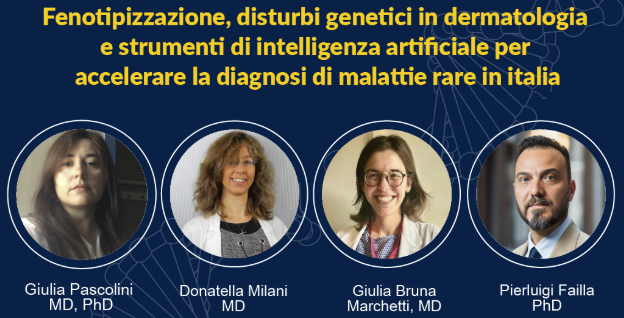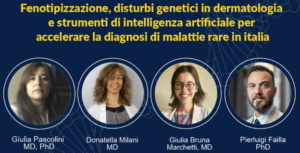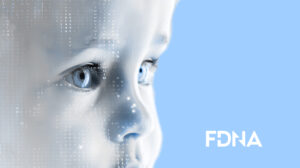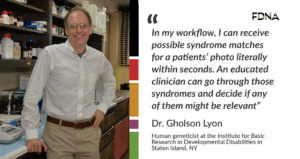In a recent landmark scientific webinar trailblazing development in dermatological phenotyping, genetic disorders, and the transformative application of artificial intelligence (AI) in rare disease diagnostics in Italy were explored. The event convened leading experts, researchers, and clinicians, who unveiled their experience in the clinic, including the innovative use of an AI-powered called Face2Gene to significantly elevate diagnostic precision and efficacy.
The webinar featured an esteemed panel of presenters, including Donatella Milani,MD, Clinical Geneticist, Head of the Pediatric Genetics Clinic at the IRCCS Foundation, Ospedale Maggiore in Milan, Italy; Giulia Bruna Marchetti, MD, New specialist in Medical Genetics at the University of Milan, Italy; Giulia Pascolini, MD PhD, Clinical Geneticist, Head of the Genetic Consultancy Service of the Dermopathy Institute of the Immacolata (IDI-IRCCS) in Rome, Italy and Pierluigi Failla, PhD, Head of AI at FDNA.
Their combined expertise provided attendees with unparalleled insights into the intersection of AI, genetics, and clinical practice.
The webinar covered several significant topics, including:
- The integration of Face2Gene in diagnosing Chromatinopathies and its application both during and after the diagnostic process as well as the utility of the tool in differential diagnoses and recognizing distinctive facial characteristics associated with rare genetic disorders
- A deeper exploration of lesser-known malformation syndromes, such as trichothiodystrophies, and other rare clinical entities presenting with cutaneous phenotypes.
- A Brief Explanation of the AI Technology Behind Face2Gene
Key Highlights
1. The Role of AI in Diagnosing Chromatinopathies
One of the most anticipated presentations revolved around the use of Face2Gene, a facial phenotyping tool powered by AI, in identifying Chromatinopathies, a group of rare genetic disorders caused by mutations in chromatin-remodeling genes. These often present with distinctive facial features that can guide clinicians toward a diagnosis. The presentation by Dr Giulia Marchetti focuses on differential diagnoses based on distinctive facial characteristics of this group of genetic disorders.
Further to the introduction by Dr Marchetti, Dr. Donatella Milani demonstrated how Face2Gene facilitates early and accurate diagnosis of chromatinopathies by analyzing facial photographs and identifying characteristic patterns linked to specific syndromes. Additionally, this session explored specific examples where distinctive facial characteristics, when analyzed by Face2Gene, led to the identification of syndromes that might otherwise have gone unrecognized.
- Confirm the genetic findings through phenotypic correlations.
- Develop tailored management plans by understanding the spectrum of phenotypic manifestations.
Beyond diagnosis, the tool also aids in post-diagnostic processes, helping clinicians, which was presented by Dr Giulia Marchetti. She showed the tool’s ability to compare facial features across a broad database of syndromes helps narrow down diagnostic possibilities, especially in complex cases. Dr. Marchetti highlighted:
- How the software enhances the accuracy of clinical evaluations.
- Its role in training clinicians to recognize subtle phenotypic differences.
2. Beyond Well-Known Malformation Syndromes: Trichothiodystrophies
This presentation delved into rare clinical entities with dermatological phenotypes, with a particular focus on trichothiodystrophies (TTDs). These ultra-rare conditions, characterized by brittle hair, photosensitivity, and other systemic manifestations, pose significant diagnostic challenges due to their rarity and phenotypic overlap with other disorders.
Dr. Giulia Pascolini underscored the importance of phenotyping tools in distinguishing TTDs from other syndromes. This discussion highlighted:
- The role of advanced imaging and genetic sequencing in complementing phenotyping.
- Case studies illustrating successful diagnoses of TTDs and related conditions.
3. The AI Technology Behind Face2Gene
The webinar concluded with a short technical presentation by Dr. Pierluigi Failla, who delved into the algorithms underpinning the tool, focusing on the capabilities of DeepGestaltTM and GestaltMatcherTM to enhance diagnostic accuracy and identify nuanced phenotypic patterns.
This event emphasized the transformative potential of combining traditional clinical expertise with innovative AI tools like Face2Gene in dermatology and genetic diagnostics. By enabling faster and more precise identification of rare diseases, these technologies are revolutionizing patient care, especially in fields where early intervention can significantly impact outcomes.



